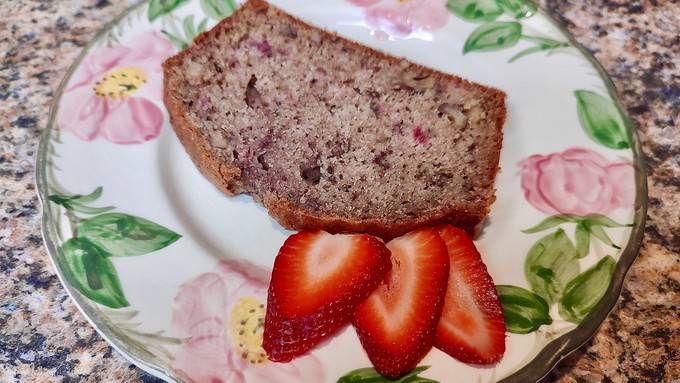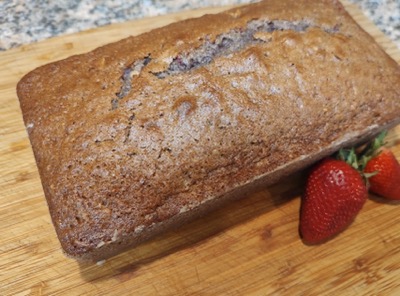
Recipe: Strawberry quick bread with walnuts

Strawberries and walnuts give this quick bread its flavor. Debbie Arrington
Fresh strawberries can be beautiful one day and not so pretty the next.
Turn those less than perfect strawberries into something yummy: Strawberry quick bread.
This versatile and easy bread can brighten breakfast, provide afternoon snacks or (with a little whipped cream) become a simple dessert. Bits of strawberry are in every bite.
Fresh strawberries offer the most flavor, but this recipe can be made with previously frozen (and drained) strawberries, too.
Strawberry quick bread
Makes 1 loaf (about 12 servings)
Ingredients:
1 cup strawberries, pureed or mashed
1 tablespoon sugar
1-1/2 cups all-purpose flour
1 cup sugar
1 teaspoon pumpkin pie spice
1 teaspoon baking powder
½ teaspoon baking soda
½ teaspoon salt
½ cup vegetable oil
2 eggs, lightly beaten
1 cup walnuts, chopped
Instructions:
Preheat the oven to 350 degrees F.
Grease and flour a 9-by-5-inch loaf pan. Set aside.
Puree or mash 1 cup strawberries (about 12 large berries). Add 1 tablespoon sugar; set aside.
In a large bowl, sift together flour, 1 cup sugar, pumpkin pie spice, baking powder, baking soda and salt.

In another bowl, combine strawberries with oil and beaten eggs. Add strawberry mixture to dry ingredients and blend just until moist. Fold in chopped walnuts.
Pour batter into the prepared loaf pan. Bake at 350 degrees for 45 to 50 minutes or until a toothpick inserted near the center comes out clean.
Let cool in the pan for 10 to 15 minutes. Remove from the pan and let it continue to cool at least another 10 minutes before slicing.
Serve warm or room temperature.
Comments
0 comments have been posted.Sacramento Digs Gardening to your inbox.
Sites We Like
Garden Checklist for week of July 21
Your garden needs you!
* Keep your vegetable garden watered, mulched and weeded. Water before 8 a.m. to reduce the chance of fungal infection and to conserve moisture.
* Feed vegetable plants bone meal, rock phosphate or other fertilizers high in phosphate to stimulate more blooms and fruiting. (But wait until daily high temperatures drop out of the 100s.)
* Don’t let tomatoes wilt or dry out completely. Give tomatoes a deep watering two to three times a week.
* Harvest vegetables promptly to encourage plants to produce more. Squash especially tends to grow rapidly in hot weather. Keep an eye on zucchini.
* Pinch back chrysanthemums for bushy plants and more flowers in September.
* Remove spent flowers from roses, daylilies and other bloomers as they finish flowering.
* Pinch off blooms from basil so the plant will grow more leaves.
* Cut back lavender after flowering to promote a second bloom.
* It's not too late to add a splash of color. Plant petunias, snapdragons, zinnias and marigolds.
* From seed, plant corn, pumpkins, radishes, winter squash and sunflowers.